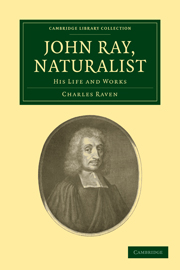Book contents
- Frontmatter
- Contents
- Preface
- Introduction
- ABBREVIATIONS
- Chapter I Boyhood and Youth
- Chapter II At Cambridge University
- Chapter III First Studies in Science
- Chapter IV The Cambridge Catalogue
- Chapter V The Years of Travel
- Chapter VI The English Catalogue
- Chapter VII The Years of Varied Output
- Chapter VIII The Structure and Classification of Plants
- Chapter IX The History of Plants
- Chapter X The Flora of Britain
- Chapter XI Last Work in Botany
- Chapter XII The Ornithology
- Chapter XIII The History of Fishes
- Chapter XIV Of Mammals and Reptiles
- Chapter XV The History of Insects
- Chapter XVI Of Fossils and Geology
- Chapter XVII The Wisdom of God
- Conclusion
- Index
Chapter IV - The Cambridge Catalogue
Published online by Cambridge University Press: 07 September 2010
- Frontmatter
- Contents
- Preface
- Introduction
- ABBREVIATIONS
- Chapter I Boyhood and Youth
- Chapter II At Cambridge University
- Chapter III First Studies in Science
- Chapter IV The Cambridge Catalogue
- Chapter V The Years of Travel
- Chapter VI The English Catalogue
- Chapter VII The Years of Varied Output
- Chapter VIII The Structure and Classification of Plants
- Chapter IX The History of Plants
- Chapter X The Flora of Britain
- Chapter XI Last Work in Botany
- Chapter XII The Ornithology
- Chapter XIII The History of Fishes
- Chapter XIV Of Mammals and Reptiles
- Chapter XV The History of Insects
- Chapter XVI Of Fossils and Geology
- Chapter XVII The Wisdom of God
- Conclusion
- Index
Summary
The Catalogus Plantarum will be a florid ornament to Cambridge.
Samuel Hartlib to John Worthington, Worthington's Diary, i, p. 174.Of the condition of science at the time when Ray first devoted himself to it there is abundant evidence in his own writings. The literature in each department of zoology will best be considered when we treat of his contribution to it. But though he had certainly read the works of Gesner and his English friends Caius and Mouffet before he published his first book and had a good knowledge of Aristotle, Pliny, Dioscorides and the other ancients, it was then only in botany that he was a master.
Here so far as Britain is concerned the foundation had been laid by Ray's Cambridge predecessor, William Turner, a student at Pembroke Hall, elected to a fellowship in 1531 and compiling his first essay, Libellus de re herbaria novus, in 1538. Turner gives a clear account of the total ignorance of botany in the University at that time: ‘I could never learn one Greek neither Latin nor English name, even amongst the physicians, of any herb or tree…and as yet there was no English Herbal but one full of unlearned cacographies and falsely naming of herbs.’ Enthusiasm for the Reformation drove Turner from Cambridge into exile: he travelled widely, met Gesner and studied botany at Bologna under Luca Ghini, the first professor of the subject, and published a second tract in 1548.
- Type
- Chapter
- Information
- John Ray, NaturalistHis Life and Works, pp. 72 - 110Publisher: Cambridge University PressPrint publication year: 2009First published in: 1942



